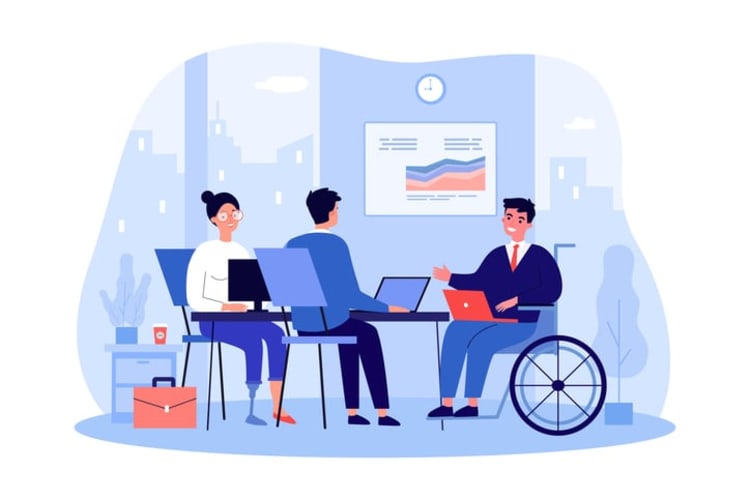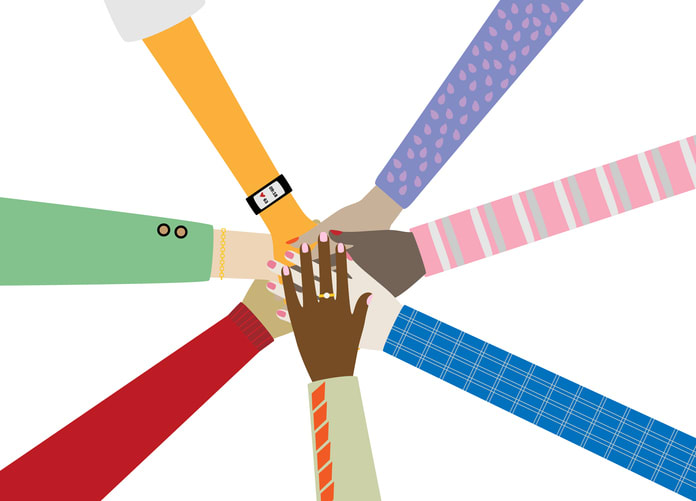In today’s increasingly interconnected world, creating a diverse and inclusive workplace is not only the right thing to do, but also a smart business decision. A diverse and inclusive workforce fosters innovation, creativity, and improved business performance, giving organizations a competitive edge in the global market. So, how can organizations effectively implement diversity and inclusion strategies and overcome common challenges? This comprehensive guide will walk you through the essential aspects of diversity and inclusion, providing valuable insights and practical advice on how to create a thriving workplace where everyone can contribute fully and achieve their full potential.
Key takeaways
- Understanding diversity and inclusion, as well as the business case for it
- Implementing effective strategies such as leadership commitment, inclusive hiring practices, and employee training & development
- Overcoming common challenges through addressing unconscious bias and fostering an inclusive culture
Understanding diversity and inclusion

Diversity and inclusion are often used interchangeably, but they refer to distinct concepts that complement each other. A diverse workforce comprises individuals with different backgrounds, experiences, and perspectives, while an inclusive workplace is one where all employees feel valued, respected, and have equal access to opportunities and resources.
Creating a successful workplace environment involves nurturing a sense of belonging and fostering collaboration and innovation by emphasizing both diversity and inclusion.
Defining diversity
When we talk about diversity, we refer to the myriad characteristics and backgrounds of individuals in the workplace. This includes, but is not limited to, factors such as:
- Gender and gender identity
- Sexual orientation
- Religion
- Age
- Ethnicity
- Race
- Geographical location
- Culture
- Class
- Physical abilities
By embracing a diverse workforce, organizations can benefit from the unique ideas, perspectives, and values that these individuals bring to the table, ultimately leading to increased innovation and creativity.
Promotion of racial and ethnic diversity, in addition to gender diversity, has become a focal point within the workplace in recent years. Most gender diverse companies recognize the importance of having a balanced representation of employees from different backgrounds, ensuring equal access to opportunities for all. By valuing and celebrating the unique contributions of underrepresented groups, organizations can create a more inclusive and equitable workplace culture that fosters collaboration and drives business success.
Defining inclusion
Contrary to diversity, which refers to the differences among individuals, inclusion is centered around crafting a welcoming and supportive atmosphere for everyone, regardless of their identity or role within the organization. Inclusion involves ensuring that all employees feel valued, respected, and have equal access to opportunities and resources, ultimately fostering a sense of belonging and community. Inclusive workplaces are characterized by open communication, mutual respect, and a commitment to recognizing and celebrating the unique perspectives and contributions of all employees.
Attracting and retaining diverse talent, promoting employee engagement, stimulating creativity and facilitating business expansion necessitate an inclusive culture. By fostering an inclusive environment, organizations can unlock the full potential of their workforce, empowering employees to contribute fully and excel in their roles.
Inclusive workplace culture is not an overnight achievement, but requires ongoing efforts from leaders, HR, and employees to ensure that everyone feels valued, respected, and supported.
The business case for diversity and inclusion

There is a strong business case for diversity and inclusion, as research indicates that organizations with diverse and inclusive workforces are more likely to outperform their competitors. Companies that prioritize diversity and inclusion enjoy numerous benefits, such as enhanced employee engagement, increased innovation and creativity, and improved business performance.
This section delves into these benefits and explores the ways organizations can harness diversity and inclusion to spur growth, revenue, and profit.
Enhanced employee engagement
Employee engagement is a crucial driver of organizational success, as engaged employees are more productive, satisfied, and committed to their roles. Inclusion plays a vital role in driving employee engagement, as employees who feel valued and included are more likely to be engaged in their work. Increased employee engagement, in turn, leads to higher productivity, job satisfaction, and enhanced business performance.
Organizations can boost employee engagement by focusing on demonstrating leadership commitment, implementing effective hiring practices, and offering employee training and development. By fostering a diverse and inclusive work environment, companies can create a positive cycle where increased employee engagement leads to greater innovation, creativity, and ultimately, improved business performance.
Increased innovation and creativity
A diverse workforce in a diverse workplace brings fresh ideas and perspectives to the table, fostering innovation and creativity in problem-solving and decision-making. When employees from different backgrounds collaborate, they can generate more imaginative solutions and make more astute decisions, ultimately driving organizational growth and success.
Inclusion is a key factor in unlocking the full potential of a diverse workforce, as it ensures that all employees feel valued, respected, and supported in contributing their unique perspectives and ideas. By creating an inclusive environment, organizations can encourage collaboration, creativity, and innovation, ultimately reaping the numerous benefits of a diverse and inclusive workforce.
Improved business performance
Companies with diverse and inclusive workforces often outperform their competitors in terms of revenue, profitability, and overall business success. Research indicates that there is a strong association between diversity on executive teams and the likelihood of financial outperformance. By promoting diversity and inclusion, organizations can drive growth, revenue, and profit, ultimately achieving a competitive edge in the global market.
To improve business performance through diversity and inclusion, organizations should focus on leadership commitment, inclusive hiring practices, and employee training and development. By implementing these strategies, companies can create a diverse and inclusive workforce that drives innovation, creativity, and ultimately, business success.
Implementing effective diversity and inclusion strategies

Implementing effective diversity and inclusion strategies requires a multi-faceted approach that involves leadership commitment, inclusive hiring practices, and employee training and development.
This section explores each of these key components and offers practical advice on effective implementation of diversity and inclusion strategies, to establish a thriving workplace where everyone can fully contribute and reach their full potential.
Leadership commitment
Leaders play a crucial role in driving and supporting diversity and inclusion efforts. Their actions, decisions, and behaviors set the standard for the organization and influence the attitudes and behaviors of employees. To demonstrate their commitment to diversity and inclusion, leaders should:
- Set clear goals for diversity and inclusion within the organization
- Promote inclusive policies and practices
- Hold themselves accountable for progress and regularly assess and report on diversity and inclusion initiatives
By taking these steps, leaders can create a culture of diversity and inclusion within their organization.
In addition to demonstrating commitment, leaders should also promote a culture of continuous learning and improvement, encouraging employees to:
- Challenge their own biases and assumptions
- Embrace new ideas and perspectives
- Seek feedback and constructive criticism
- Engage in ongoing professional development
- Take risks and learn from failures
By fostering a culture of openness, respect, and accountability, leaders can create a more inclusive and equitable workplace that supports the success of all employees.
Hiring practices
Inclusive hiring practices are essential for creating a diverse and inclusive workforce. Organizations should strive to diversify their candidate pools, use unbiased recruitment methods, and focus on culture add rather than culture fit. By addressing unconscious bias in the hiring process and providing equal opportunities for all job seekers, organizations can attract and retain top talent from a wide range of backgrounds and experiences.
Some examples of inclusive hiring practices include blind resumes, which remove identifying information from resumes to reduce unconscious bias, and inclusive job postings, which use gender-neutral language and highlight the organization’s commitment to diversity and inclusion. By implementing these practices, organizations can create a more diverse and inclusive workforce that drives innovation, creativity, and overall business success.
Employee training and development
Employee training and development programs should address diversity and inclusion topics, such as unconscious bias, communication, and collaboration. By providing employees with the knowledge, skills, and tools to recognize and address their own biases and work effectively with others, organizations can create a more inclusive and equitable workplace where all employees can contribute fully and thrive.
Successful employee training and development initiatives include:
- Diversity and inclusion training
- Unconscious bias training
- Communication training
- Collaboration training
By investing in these programs, organizations can equip their employees with the skills and knowledge necessary to foster a diverse and inclusive workplace that supports the success of all employees.
Overcoming common challenges in diversity and inclusion

Overcoming common challenges in diversity and inclusion involves addressing unconscious bias, fostering an inclusive culture, and measuring success.
This section explores these challenges and provides practical advice on how organizations can surmount these obstacles to forge a more diverse and inclusive workplace.
Addressing unconscious bias
Unconscious bias can hinder diversity and inclusion efforts, as it can lead to prejudicial treatment or discrimination, creating an environment that is not conducive to inclusivity or equity.
To address this issue, organizations should:
- Provide training and resources to help employees recognize and mitigate their biases
- Foster a culture of open dialogue and awareness around unconscious bias
- Implement policies and practices that promote diversity and inclusion
- Regularly evaluate and assess the impact of unconscious bias on decision-making processes
By taking these steps, organizations can ensure that all employees are treated fairly, fostering a more inclusive and equitable workplace.
Some strategies for addressing unconscious bias include providing unconscious bias training, instituting diversity and inclusion policies, and establishing a safe and inclusive environment. By implementing these strategies, organizations can create a more inclusive and equitable workplace where all employees feel valued, respected, and supported.
Fostering an inclusive culture
Fostering an inclusive culture requires ongoing communication, support, and recognition of diverse perspectives and contributions. To create an inclusive culture, organizations should focus on establishing a diverse and inclusive workplace, promoting open discourse, and ensuring equal opportunities for all employees.
By fostering an inclusive culture, organizations can:
- Create a more diverse and inclusive workforce that drives innovation, creativity, and overall business success
- Reduce turnover rates
- Improve employee satisfaction
- Enhance overall workplace morale.
Bridging the digital divide with a virtual workspace
In today's rapidly evolving work landscape, nurturing a positive workplace culture and fostering collaboration has become crucial for hybrid, distributed, and remote teams. Consequently, many companies are adopting virtual workspace platforms, which have become pivotal in supporting Diversity, Equity, and Inclusion (DEI) goals.
Kumospace, recognized as the industry-leading virtual workspace, offers an immersive experience that transcends traditional video conferencing. By establishing an interactive virtual environment, it promotes organic conversations and interactions reminiscent of a physical office setting. Employees can seamlessly move between breakout rooms, engage in spontaneous discussions, or gather around virtual water coolers, mirroring the in-person nuances often lost in digital communication. This approach not only bridges the gap created by remote work but also reinforces a sense of community and camaraderie among team members. By utilizing Kumospace, companies can ensure that their teams stay connected, collaborative, and culturally aligned, regardless of their physical location.
Measuring success
Measuring the success of diversity and inclusion initiatives is essential for continuous improvement and demonstrating the value of these efforts to the organization. Organizations should track diversity and inclusion metrics, conduct surveys, and assess employee feedback to evaluate the effectiveness of their initiatives and identify areas for improvement.
By measuring success, organizations can gain valuable insights into the impact of their diversity and inclusion efforts and use this information to refine their strategies and drive continuous improvement. This data-driven approach can help organizations create a more inclusive and equitable workplace that supports the success of all employees.
Diversity, Equity, and Inclusion (DEI) in action
-in-action.jpg?tx=c_scale,w_693,h_504)
Diversity, Equity, and Inclusion (DEI) in action includes employee resource groups, successful DEI initiatives, and lessons learned from real-world examples. This section explores each of these components and offers practical advice on how organizations can utilize these lessons to enhance their own diversity and inclusion strategies.
Employee resource groups
Employee resource groups (ERGs) are voluntary, employee-led groups that promote diversity, equity, and inclusion within the organization. These groups, based on shared interests, values, or identities, provide assistance, community, and a sense of belonging for employees.
ERGs can play a crucial role in fostering an inclusive workplace culture by promoting open communication, collaboration, and support for employees from diverse backgrounds. Organizations should support the establishment and growth of ERGs by providing resources, guidance, and leadership commitment. By fostering strong ERGs, organizations can create a more inclusive and equitable workplace that supports the success of all employees.
Successful DEI Initiatives
Successful DEI initiatives often involve collaboration between leadership, HR, and employees, as well as a focus on continuous improvement and learning. By fostering a culture of learning and improvement, organizations can create a more inclusive and equitable workplace that supports the success of all employees.
Examples of successful DEI initiatives include:
- The implementation of inclusive hiring practices
- The provision of training and resources to address unconscious bias
- The establishment of employee resource groups
By learning from these successful efforts, organizations can enhance their own diversity and inclusion strategies and create a more inclusive and equitable workplace.
Lessons learned

Lessons learned from successful DEI efforts can provide valuable insights and guidance for organizations looking to enhance their own diversity and inclusion strategies. By examining the successes and challenges faced by other organizations, companies can identify best practices and potential pitfalls to avoid in their own efforts.
Some key takeaways from successful DEI efforts include the importance of leadership commitment, the need for ongoing communication and support, and the value of continuous improvement and learning. By applying these lessons, organizations can create a more diverse and inclusive workplace that supports the success of all employees.
Summary
In conclusion, fostering a diverse and inclusive workplace is not only the right thing to do, but also a smart business decision. By implementing effective diversity and inclusion strategies, overcoming common challenges, and learning from successful DEI efforts, organizations can create a thriving workplace where everyone can contribute fully and achieve their full potential. The journey toward a more diverse and inclusive workplace requires ongoing commitment, collaboration, and learning, but the benefits are well worth the effort.
The following section addresses common questions and misconceptions about diversity and inclusion in the workplace, providing clear and concise answers to promote a better understanding of these important concepts.
Diversity and inclusion are two unique concepts which work in tandem. They are intricately connected to one another. Diversity is about diversity.
Frequently asked questions
Inclusion and diversity in the workplace are about making everyone feel equally supported and included, regardless of race, ethnicity, gender identity, age or any other differences.
It is also about creating an environment where people feel accepted and empowered to be their best selves.
Hiring people from different backgrounds, providing equal professional development opportunities, and creating a safe space for employees to discuss their identity are examples of diversity and inclusion.
Diversity in the workplace can be classified into four major types: internal, external, organizational, and worldview.
It is important to understand and represent these different types of diversity in the workplace to ensure a healthy work environment.
There are three major differences between diversity and inclusion: diversity refers to the representation of different people in an organization, inclusion is ensuring equal opportunity and influence at all levels of a workplace, and belonging is creating a safe environment for all.
Inclusion is how we enable diversity to thrive and create a culture that promotes acceptance and belonging.
Organizations can effectively implement diversity and inclusion strategies by committing leadership, instituting inclusive hiring practices, and providing employee training and development.
Leadership must be committed to the cause and set the tone for the organization. Inclusive hiring practices should be established to ensure that all qualified candidates are considered for positions. Employee training and development should be provided to ensure that employees are trained and developed.





